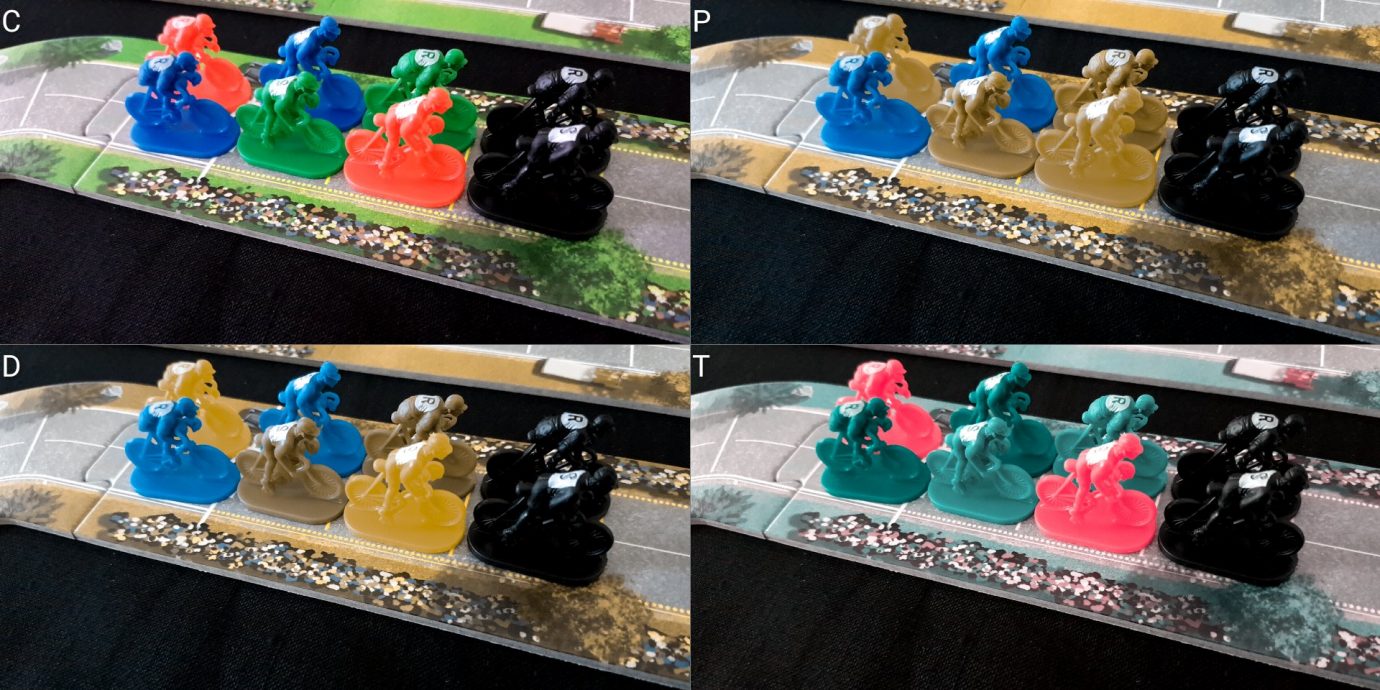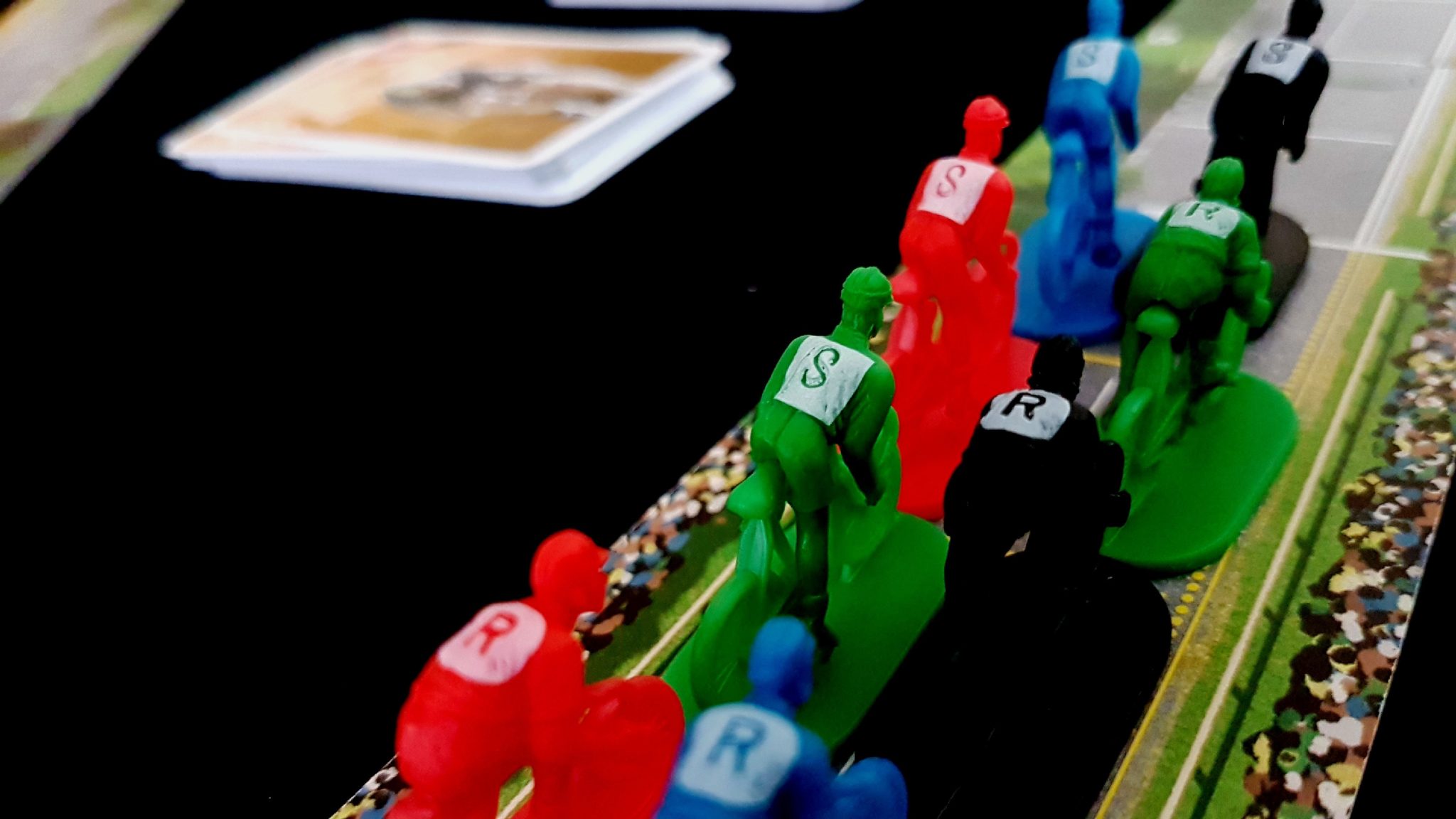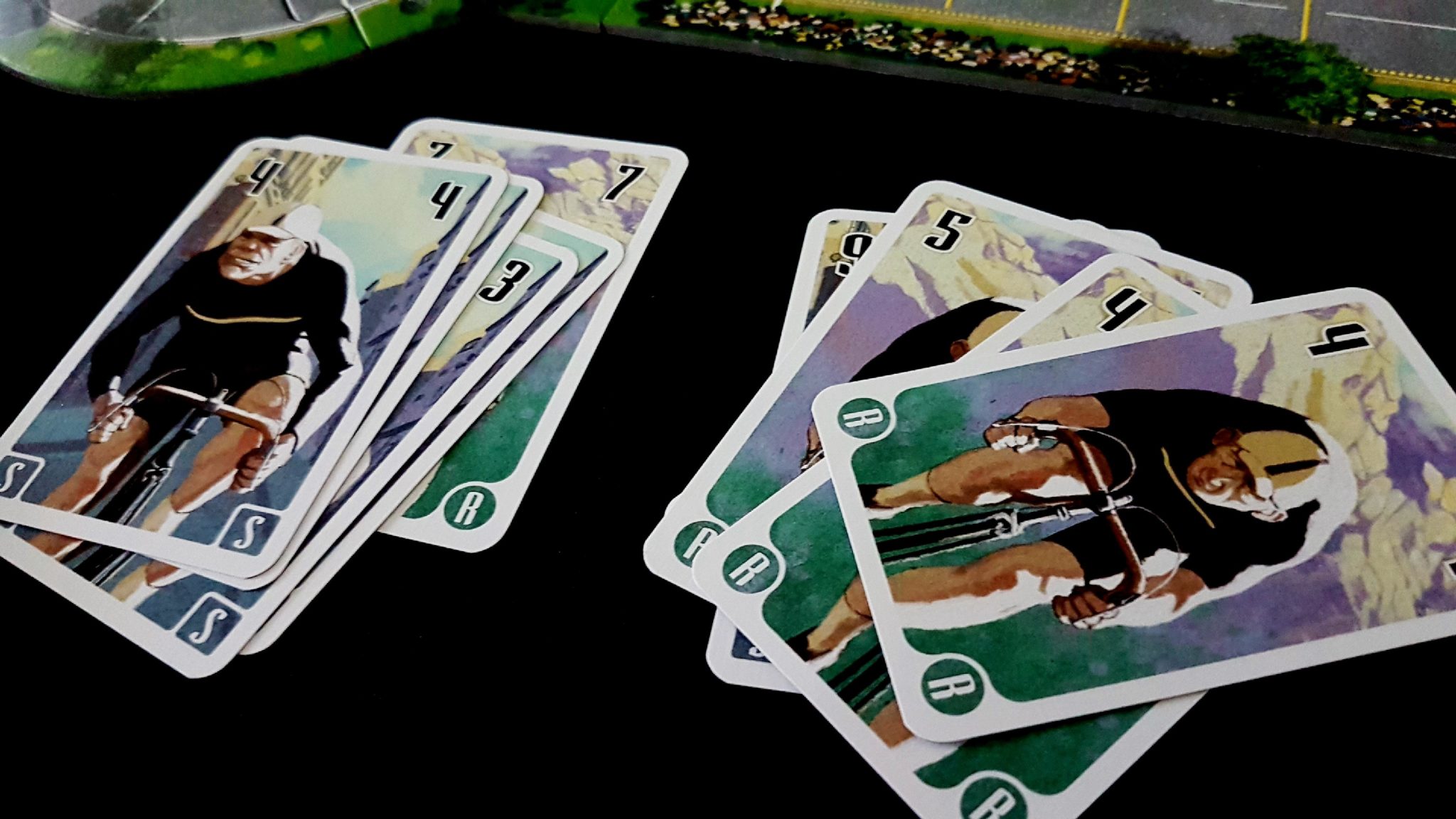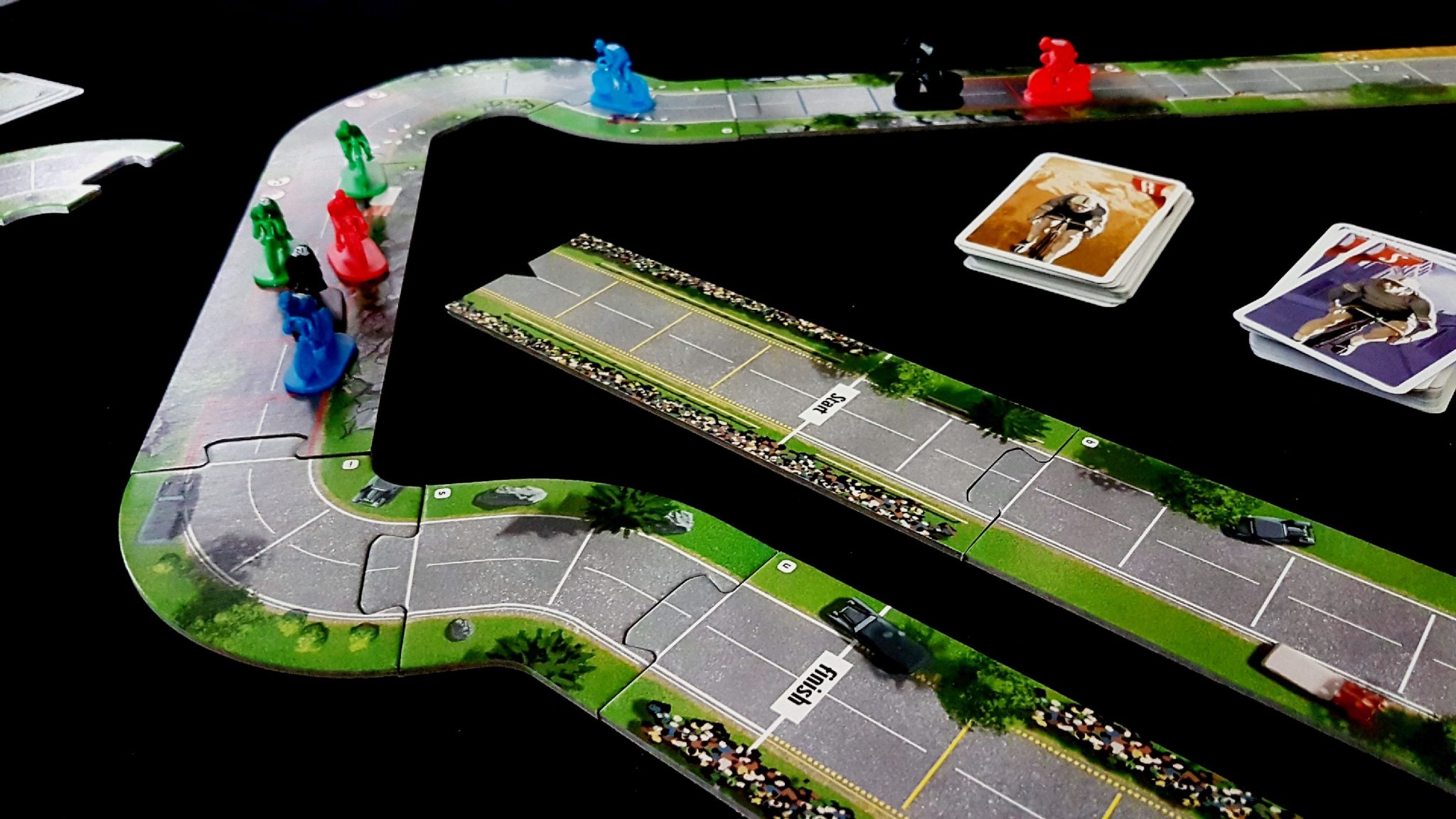Table of Contents
| Game Details | |
|---|---|
| Name | Flamme Rouge (2016) |
| Review | Meeple Like Us |
| Complexity | Medium Light [1.69] |
| BGG Rank | 258 [7.50] |
| Player Count | 2-4 |
| Designer(s) | Asger Harding Granerud |
| Buy it! | Amazon Link |
Version Reviewed
Introduction
Flamme Rouge is a likeable, well executed game of fast men going fast to show which of them is the fastest. We liked it a lot, which is why it got four stars in our review. However, we also made note in that review that there are some baffling component decisions that are almost certainly going to come up in this teardown. Components can drastically improve the fun of a game, but they can also serve as a major roadblock in a teardown like this. How accessible then is this game about cycling the eponymous Red Flannel road? You’d best get your helmet, because it could get bumpy as we mount up and ride the hell out of this game.
Colour Blindness
Colour blindness is poorly handled because the only way to tell cyclists apart is by colour. Or, more precisely, it’s the the only way to tell apart cyclists of a particular class – the rouler and the sprinteur have slightly different moulds and show their letter on the back. That’s not a huge amount of good though for many players looking to identify just how badly they’re messing up the race. They’ll know a sprinteur or a rouler is there, but they might not be able to tell to whom it belongs.

‘Does my team have four cyclists or what?’
As far as individual cards go there is a colour issue but it’s not significant – each team has a different graphical image on the card, and in any case cards have relevance only within a player’s local area. What you play matters, but it doesn’t matter to the extent you need to be able to differentiate colour to ascertain key information.

‘I think you’re spending my cards, buddy’
You can replace the cyclist tokens with other representative elements, and it’s most likely to be an issue in a four player game – that is, assuming only one kind of colour blindness must be accommodated at the table. If close inspection is undertaken, there are subtle cues that can be used to differentiate shades in optimal lighting. It’s still going to be difficult for some people to determine position of their riders in a game that is all about determing the position of your riders. It’s possible to inquire of the table but that strikes me as an easy way 0to leak gameplay intention. The only reason you are going to be interested in which player is in a particular location, if it’s not you, is that you plan on making use of the observations you’ve made about their card play to date. Even iin circumstances where that’s not a factor this is a 2016 game and it remains the case that issues like this simply shouldn’t be emerging.
We tentatively recommend Flamme Rouge in this category.
Visual Accessibility
There’s quite a lot of visual parsing involved here, and the nature of the game means that play in earlier sections is going to be highly dependent on the way the course evolves in later sections. The presence of hills in particular has a powerful impact on the way in which card play must evolve – later stages with lots of hills argue that it’s best to use high cards early, whereas early stages with lots of hills argue the opposite. The exact nature and composition of the track will tell a player where the balance should lie. Some of that is likely to be situational, based on the position of players when they get to the hills. Both factors need to be incorporated to make sensible decisions in play.

There’s a lot of track
The cycles offer a degree of tactility here that can substitute for visual information, but while you can (probably) tell a roleur from a sprinteur you can’t tell the difference between cyclists in a class that belong to different teams. Each kind of cyclist has their letter symbol on the back, but this isn’t particularly accessible in most circumstances you’d actually need it – close inspection is going to be necessary in most situations.

Can you tell your Rs from your elbowS?
You can certainly feel for position of cyclists on the track, but the track itself has no notches or tactile indicators that could be used to situate cyclist position in relation to the spaces they occupy. This combined with the card play renders the game almost unplayable to those for whom total blindness must be considered excepting in circumstances where very extensive support is provided by the table.
For those with less severe visual impairments, the specific tracks are difficult to put together because of the small symbols used to indicate piece and the tiny letters used on the track cards. While it’s not impossible for someone to do this without assistance it either requires a lot of hunting through a stack of track pieces for what you need or an inconvenient amount of preparatory sorting.

Tiny letters, and lots of them
The side of the track a cyclist is on is important, and this is indicated by a double line to show the ‘rightmost’ edge of the track. The cyclist closest to the right is ahead of any other cyclist in the same space. However, while this isn’t visually accessible it’s also possible to simply trace from the starting point to know which cyclist is the one that is technically speaking farthest ahead.

Each one represents seconds of your life ebbing away
For the cards, it’s easy to tell at a glance the difference between exhaustion and regular cards, and it’s straightforward with experience to tell which cards belong to the rouler and which to the sprinteur. The numbers on these cards are always at the top corners and are reasonably, but not perfectly, contrasted – more obvious letterboxing behind the figures would have been welcome. You’re only ever dealing with four of these at a time though, and while you place the card for each rider separately you have to do one without reference to the hand you drew for the other. As such, there isn’t a lot of cross-referencing cards against riders but there is quite a lot of cross-referencing cards against the relative position of cyclists on the track.
Given all of this, we don’t recommend Flamme Rouge in this category but if players really want to make the effort they will probably be able to play it with care.
Cognitive Accessibility
As far as the rules go, Flamme Rouge is a straightforward game that doesn’t have many sticking points in terms of cognitive accessibility. The more complex mechanisms (drafting and hills) can either be omitted or handled by another player at the table if necessary. However, playing cards well is a much more difficult task and is made up of a number of cognitively demanding subtasks.
First of all, the numeracy involved here is not complicated but it is quite complex. Realistically all you’re doing is picking a card and moving that number of spaces. There are certain spaces you’ll want to hit though (downhill sections, as an example) and other spaces that modify the value of cards. Working out the best card to play based on where you are in the track involves a fair degree of probability, assessment of the composition of your deck, and projecting forward to what cards you are likely to have available in the next round. There’s not a lot of point stopping in a downhill section if all of your cards are likely to be higher than five. The value of a downhill section intensifies if you think all you have left are exhaustion cards that could be made to work well for you.
Even that pales into insignificance when we consider the real cognitive cost of the game – playing the cards that let you take advantage of the cyclist pack. You want to leave a single space between your cyclist and another cyclist to take advantage of slipstreams. You also want to make sure that if you can’t accomplish that you do at least land right behind at least one other player so as to prevent the accumulation of exhaustion. That’s not as simple as arithmetic calculation, even when it comes to placing one of your riders behind another. The probability of the decks along with the actions of other players are going to profoundly impact on that. That’s expensive in terms of pure computation but also in terms of the memory burden it puts on players. Since you need to play one card without reference to the other, there’s also a small but persistent memory burden that comes with remembering what card you just played down. It may not sound like much, but it does have an impact. You can look at your played card at any time but on occasion I’ve had to rethink a plan because in the process of assessing the hand in front of me I forgot what I was planning with the hand I just recycled.
Other than this, there isn’t much in Flamme Rouge to be concerned about, but this issue is tremendously troublesome. A version of the game that didn’t make use of slipstreaming would be far more cognitively accessible, and one making use of the simpler tracks without hills would likely be playable by almost everyone. However, neither of those games are likely to be fun to play and at that point you might as well simply play a game where you’re getting a greater proportion of the base experience with less house-ruling.
We can tentatively recommend Flamme Rouge in both categories of cognitive accessibility, but bear in mind that there is a considerable difference between being able to play the game and being able to play the game well.
Emotional Accessibility
Competition in Flamme Rouge is extremely indirect – really, all that an opponent can do to upset you is not be where you hoped they would and that’s not really their fault. Occasionally you may find an opponent snags a prize space behind another cyclist and you’re forced back – but that’s really about it.
However, that’s not to say that it’s otherwise fine – there is a very significant despair curve that can come with the game. If you fall behind, you’ll tend to stay behind because of the way exhaustion accumulates. A rider that falls too far behind will often find themselves unable to get out of a failure cascade – especially on trickier courses where there are lots of uphill areas and few opportunities to freewheel downhill. It’s entirely possible for neither of your riders to be anywhere near the finish line when everyone else has made it comfortably across and that’s not a great place to be. Usually it doesn’t happen, and a mitigating factor is there are no score disparities as such since the winner is whoever made it most comfortably across the end.

Good luck, red
The issue here is that there’s no ability to catch up in these circumstances – even if you have sevens and nines available they’re only as valuable as the course permits them to be. You might find yourself drawing all your high value cards as you hit an uphill, forcing you to waste them without access to a slipstream to compensate. Every single round you accumulate exhaustion makes the cards you need less likely to appear. There’s a certain point where you have to accept you’re out of the race but there’s no clean mechanism for bowing out of play that doesn’t make you look like a sore loser.
We’ll recommend Flamme Rouge in this category, because while this is an issue it’s also something that can spun into comedy if the group approaches it in the right way. Its effect is also intermittent and not something you’d experience in every game.
Physical Accessibility
I don’t know who decided that the minis should include a detachable cyclist but they should feel bad about it. They have introduced for everyone that plays the game a persistent and entirely unnecessary physical accessibility burden that can make play intensely frustrating. So, well done on that. A single, unified piece would have been so much better here and whatever benefit was assumed to come from the approach taken absolutely isn’t worth it.
If you pick up one of the minis by the cyclist, they’ll come loose. If you nudge the vacuum pack in which they reside, they’ll probably come loose. If you drop the box, they’ll come loose. And the pins that would connect the pedals on the cyclist to the bicycle are incredibly small and it’s really, really difficult to clip everything back into position when it happens. You’re usually left with a cyclist perched awkwardly in a way that would definitely result in serious groin strain in an actual race.

What the actual hell
I went to the trouble of simply gluing my pieces in position, but they weren’t perfectly aligned with the invisible holes in the wheels or the grips on the handlebar. They are at a slight angle. That’s fine really, except they no longer fit neatly into the vacuum pack of the box. Seriously, what the hell was anyone thinking here? URGH.
The track tends to sprawl a lot, but since all you’re doing is moving a bike according to fixed movement rules it’s easy for someone within easy reach to action that on your behalf. One of the nicer features of the tracks too is that they have a jigsaw style connecter that means they can’t be easily dislodged. More than this, there’s actually a fair bit of give in the connectors that permits you to move subsections of the track a little if needed. All of this together means that you can move the track around without too many problems and it’s quite resistant to turbulence on the table. That is very handy because IF YOU UPSET THE TRACK THE GOD DAMN CYCLISTS WILL COME LOOSE. Oh my god, seriously. The track itself is so well designed in terms of accessibility and yet you go and do something like this.
The most significant problem that can’t be solved through verbalisation is the card play because this involves a lot of shuffling and navigating between two hands drawn from two decks of different sizes and composition. The decks dwindle away as the cards are spent, but all that means is that unlike a standard deckbuilder shuffling becomes a more, rather than less, significant issue as time goes by. It’s a deck unbuilder. However, hands exist only as long as needed for a player to select one card and it’s possible for this to be actioned on another player’s behalf even if it’s a little awkward.
We tentatively recommend Flamme Rouge in this category – it’s certainly playable but does require more cumbersome and regular intervention on the part of another player if verbalisation is needed. Also those god damn sculpts god damn you.
Communication
The entirety of the game is language independent, and there’s no need for communication during play. Being able to pronounce sprinteur and rouler is exceptionally optional, and I have taken to simply saying rooolooo because high school French was a long, long time ago.
We strongly recommend Flamme Rouge in this category.
Socioeconomic Accessibility
Given the outfits, I assume that this is some kind of mid 20th century interpretation of professional cycling, and that is borne out to an extent by the barefoot waifs running alongside the track on the box. Women line the pavements in conspicuously 30s or 40s style dresses, and the guys look like they just stepped off the set of Mad Men. It’s all quite anachronistic. And as you might expect (and was discussed in the review) women are not represented at all beyond spectator status.

Men, men, men, men
On one hand, professional cycling is still very much a men’s sport and as far as I am aware there are still no mixed gender professional racing track events of any note. But the sculpts aren’t particularly gendered and there’s no reason a more inclusive approach couldn’t have been taken. Theme can be a defence against accusations of gender imbalance, but it’s rarely very convincing. That’s the case here. Flamme Rouge is a game where you’re going to be picking a macho man, occasionally complete with pornstache, and racing him and his other male buddy around a track to beat the other men. If you needed further evidence that women aren’t included, the text of the instructions default to masculinity all the way through.
Flame Rouge has an RRP of £36, which strikes me as a reasonable price for something so tightly designed and so consistently entertaining. The modular design too means that almost certainly, should the game attain any reasonable level of success, further novelty will later be injected with different track pieces in the future. You don’t get many set tracks in the box but you can easily invent your own and that’s part of the fun. It only goes up to four players, which is a shame, but it plays all of those counts well.
We’ll tentatively recommend Flamme Rouge in this category. The price is right, but the art design is so obviously pitched at men that it’s hard to be too complimentary about the game in this section.
Intersectional Accessibility
Intersectional conditions, as you might expect, are going to turn tentative recommendations inside out. An intersection of cognitive impairments across either category would be enough for us to rescind our previous evaluations. An intersection of physical impairments with colour blindness would make inspection of cyclists more cumbersome than a recommendation could realistically bear. Likewise, a combination of physical impairments with emotional accessibility needs would make those god-damn sculpts even more frustrating and that alone would be enough for us to say ‘maybe play a game that isn’t activelytrying to mess with your calm’.
Flamme Rouge is a reasonably brisk game and if you like you can make the track as short as you want to accommodate conditions of modulating severity. It scales quite well with player count too because most of what you do is handled simultaneously until it’s evaluated. As such, the time cost of accessibility compensations don’t need to be taken into account in the usual way. The box suggests a play time of between thirty and forty-five minutes and I’d be surprised if it went over an hour in any case. As such, it’s not long enough to really exacerbate issues of distress or discomfort. Should that be a problem though, the game does permit dropping out without impact – much like in a normal race players can simply be removed from the board. There’s nothing about the game setup or game play that requires changes to be made for different player counts, and as long as there are two of you it’s possible to play the game right through to the end with no issues.
Conclusion
There are numerous problems here in terms of the accessibility of Flamme Rouge, and what’s most remarkable is how many of them are self-inflicted wounds. The colour problems, the lack of board tactility, the god damn cyclist minis, the aggressively masculine art – all of those could easily be addressed in a future edition to considerable benefit.
| Category | Grade |
|---|---|
| Colour Blindness | C |
| Visual Accessibility | D |
| Fluid Intelligence | C |
| Memory | C |
| Physical Accessibility | C |
| Emotional Accessibility | B |
| Socioeconomic Accessibility | C |
| Communication | A |
As it currently stands, Flamme Rouge does poorly almost across the board – our tentative recommendations here are often very tentative. But importantly, this is a game that almost anyone can play – the only question is how much effort they can be expected to put into it to get out a meaningful game experience. For a lot of these categories, our view is unfortunately ‘more than it’s worth’.
That’s a shame, because at four stars Flamme Rouge is a game we think genuinely veers into greatness. It’s so instantly intuitive in its mechanics, and so absorbing in its strategy, that it’s especially disappointing that same care and attention didn’t go into the accessibility of its design. There’s nothing we can do about that unfortunately, although should a second edition ever be in planning then the designer and publisher should absolutely feel free to get in touch. This a game that, in a different implementation, potentially anyone could play and I think they’d very much enjoy it if they did.
A Disclaimer About Teardowns
Meeple Like Us is engaged in mapping out the accessibility landscape of tabletop games. Teardowns like this are data points. Games are not necessarily bad if they are scored poorly in any given section. They are not necessarily good if they score highly. The rating of a game in terms of its accessibility is not an indication as to its quality as a recreational product. These teardowns though however allow those with physical, cognitive and visual accessibility impairments to make an informed decision as to their ability to play.
Not all sections of this document will be relevant to every person. We consider matters of diversity, representation and inclusion to be important accessibility issues. If this offends you, then this will not be the blog for you. We will not debate with anyone whether these issues are worthy of discussion. You can check out our common response to common objections.
Teardowns are provided under a CC-BY 4.0 license. However, recommendation grades in teardowns are usually subjective and based primarily on heuristic analysis rather than embodied experience. No guarantee is made as to their correctness. Bear that in mind if adopting them.
